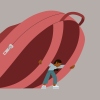
A child receives care against head lice.
LAURIE DIEFFEMBACQ/BELGA MAG/AFP via Getty Images
hide caption
toggle caption
LAURIE DIEFFEMBACQ/BELGA MAG/AFP via Getty Images
As kids head back to school, an unlucky few will likely bring home some unwanted guests – head lice.
If you remember being sent home when the school nurse found lice in your hair, you might be surprised at the Centers for Disease Control and Prevention’s current guidelines.
Students can stay in school until the end of the day, then go home for treatment, and return as long as the treatment has begun.
That guidance hasn’t changed in over a decade, the CDC told NPR, contrary to some recent news reports.
That approach makes sense, according to Dr. Dawn Nolt, a pediatrician at Oregon Health & Science University Doernbecher Children’s Hospital in Portland, Oregon.
“It takes about four to six weeks for someone to really show and start itching from head lice. And so, you know, once it’s detected, it’s probably really been there for about a month,” Nolt told NPR’s Morning Edition.
Having lice in your hair just isn’t that urgent of a condition, she said.
“It doesn’t carry any additional diseases. It’s just really a nuisance,” she added. “So we encourage that kids stay in school at least through the end of the day, and send a note or a call to the family to start treatment as soon as they can.”
Nolt also authored the American Academy of Pediatrics most recent report on head lice.
It stressed that “medical providers should educate school communities that no-nit policies for return to school should be abandoned.”
It’s difficult for kids to catch lice
As kids go back to class, parents shouldn’t worry too much about them getting lice, Nolt said.
“It’s actually pretty hard to have lice go from one head to the other because we have to remember that it crawls. It doesn’t jump, it doesn’t fly,” Nolt added.
“Your kids are relatively safe in the classroom from getting head lice from their classmates. As long as they don’t rub their heads together,” she said.
Treatment is fairly simple
After finding live lice in the hair, the treatment is simple, according to Nolt.
“There are very safe and effective FDA-approved products for head lice that are available over the counter. It’s important to follow the directions to get the best outcomes,” she said.
“You’ll know if your treatment is effective if you don’t see any lice in about seven to 10 days after your last dose of medication,” Nolt added.
If that doesn’t get rid of them, then it’s time to take your child to their doctor for a stronger prescription medication.
Stigma about lice persists
The final itch to scratch when it comes to lice is removing the stigma, Nolt believes.
“Lice is a common childhood disease. It’s found worldwide. It can attach to anyone’s head. It doesn’t discriminate,” she said.
Some commonly held beliefs about lice just don’t hold up, Nolt added.
“It’s associated with poor hygiene or houselessness or not washing your hair really well or combing it. And it’s really none of that,” she said.
So if lice visit your home in your kid’s hair, know that your child is just one of millions of cases in the U.S. every year — and pop down to the pharmacy.
This digital story was edited by Obed Manuel.


